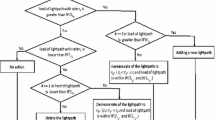Abstract
In this paper, we study the reconfiguration capability in ATM networks and its ability to reduce ATM cell losses. Digital cross-connect systems have been used in traditional reconfigurable networks to concatenate channels to avoid store- and-forward delays. We propose an implementation of the reconfiguration capability in ATM networks that restricts the transmission of cells of an O-D pair to particular channels in each physical link in a simple path from origin to destination. With this proposed implementation, digital cross-connect systems are not needed. We formulate the problem of jointly determining logical networks and the routing assignments on the logical network of a reconfigurable ATM network as a nonlinear mixed integer programming problem. We prove that the joint problem with the integrality constraints relaxed can be simplified to a convex programming problem. This provides a method to compute a lower bound on the minimum cell losses for the original problem. An algorithm is developed to solve the nonlinear mixed integer programming problem. In the computational experiments, the proposed algorithm determined a good feasible solution in a few minutes of CPU time on SUN SPARCsystem 400. In the experiments, the reconfiguration capability decreased the total cell losses by up to 80%. Problem parameters that affect the effectiveness of the reconfiguration capability in reducing ATM cell losses are identified.
Similar content being viewed by others
Explore related subjects
Discover the latest articles, news and stories from top researchers in related subjects.References
W.D. Hutcheson and T.M. Snyder, Control services based on digitial cross-connect systems, IEEE J. Selec. Areas Comm. SAC-5(1987)33–37.
R.K. Berman and R.W. Larence, Customer network management and control service,GLOBECOM (1985) pp. 18.5.1–5.
R.A. Pazos-Rangel and M. Gerla, Express pipe networks,Proc. of Global Telecommunication Conf., Miami (1982) pp. B2.3.1–B2.3.5.
R.A. Pazos-Rangel and M. Gerla, Express pipe network design,Proc. 1986 Int. Zurich Seminar on Digital Communication, Zurich (1986) pp. 61–68.
M.J. Lee and J.R. Yee, An efficient near-optimal algorithm for the joint traffic and trunk routing problem in self-planning networks,Proc. IEEE INFOCOM (1989) pp. 127–135.
CCITT Recommendation I.121, Broadband aspects of ISDN, Melbourne (1988).
K. Asatani, K.R. Harrison and R. Ballart, CCITT standardization of network node interface of synchronous digital hierarchy, IEEE Commun. Mag. 28(1990)15–20.
N.B. Sandesara, G.R. Ritchie and B. Engel-Smith, Plans and considerations for SONET deployment, IEEE Commun. Mag. 28(1990)26–33.
A.E. Eckberg, D.T. Luan and D.M. Lucantoni, Meeting the challenge: Control and flow control strategies for broadband information transport, in:Proc. IEEE Globecom (1989) pp. 49.3.1–49.3.5.
S.E. Minzer, Broadband ISDN and asynchronous transfer mode (ATM), IEEE Commun. Mag. 27(9)(1989)17–24.
A. Huang and S. Knauer, STARLITE: A wideband digital switch,GLOBECOM (1984) pp. 121–125.
J.Y. Hui and E. Arthurs, A broadband packet switch for integrated transport, IEEE J. Selec. Areas Comm. SAC-5(1987)1264–1273.
Y.S. Yeh, M.G. Hluchyj and A.S. Acampora, The knockout switch: A simple architecture for high performance packet switching, IEEE J. Selec. Areas Comm. SAC-5(1987)1274–1283.
M.G. Hluchyj and M.J. Karol, Queueing in high-performance packet switching, IEEE J. Selec. Areas Comm. SAC-6(1988)1587–1597.
M. Gerla, J.A. Suruagy Monteiro and R. Pazos, Topology design and bandwidth allocation in ATM nets, IEEE J. Selec. Areas Comm. SAC-7(1989)1253–1262.
J.A. Suruagy Monteiro and M. Gerla, Topology reconfiguration of ATM networks, in:Proc. IEEE INFOCOM (1990) pp. 207–214.
M.S. Barazaa and J.J. Jarvis,Linear Programming and Network Flows (Wiley, 1977).
M.-J. Lee and J.R. Yee, Optimal minimax routing in ATM networks,Proc. IEEE GLOBECOM (1990) pp. 505.5.1–505.5.5. Also to appear in Ann. Oper. Res.: Special issue on Methodologies for High Speed Networks.
M.-J. Lee and J.R. Yee, A design algorithm for reconfigurable ATM networks,Proc. IEEE INFOCOM (1993) pp. 144–151.
D.P. Bertsekas and E. Gafni, Projection Newton methods and optimization of multicommodity flows, IEEE Trans. Auto. Contr. AC-28 (1983)1090–1096.
M.S. Barazaa and C.M. Shetty,Nonlinear Programming: Theory and Algorithms (Wiley, 1979).
M.-J. Lee, Design algorithms for reconfigurable networks, Ph.D. Thesis, Department of Electrical Engineering Systems, University of Southern California (1991).
J.R. Yee and M.-J. Lee, Convergence of an iterative method for ATM networks,Proc. IEEE INFOCOM (1992) pp. 2472–2481.
K.R. Krishnan, The convexity of loss rate in an Erlang loss system and sojourn in an Erlang delay system with respect to arrival rate and service rate, IEEE Trans. Comm. 38(1990)1314–1316.
M.-J. Lee and J.R. Yee, A partial branch and bound design algorithm for reconfigurable networks,Proc. IEEE ICC (1991) pp. 22.6.1–22.6.5.
M.-J. Lee and J.R. Yee, A topology and discrete capacity assignment algorithm for reconfigurable networks, to appear in Oper. Res.
J. Martin,Telecommunications and the Computer (Prentice-Hall, Englewood Cliffs, NJ, 1976) pp. 91, 94.
J. Martin,Computer Networks and Distributed Processing — Software, Techniques and Architecture (Prentice-Hall, Englewood Cliffs, NJ, 1981).
P.C. Messina,The Concurrent Supercomputing Consortium, Annual Report, Fiscal Year 1991–1992, CALTECH.
Author information
Authors and Affiliations
Additional information
Supported by NSF Grants NCR 90-16348 and NCR 92-23148.
Rights and permissions
About this article
Cite this article
Lee, M.J., Yee, J.R. A design algorithm for reconfigurable ATM networks. Telecommunication Systems 2, 197–224 (1993). https://doi.org/10.1007/BF02109858
Received:
Revised:
Issue Date:
DOI: https://doi.org/10.1007/BF02109858




